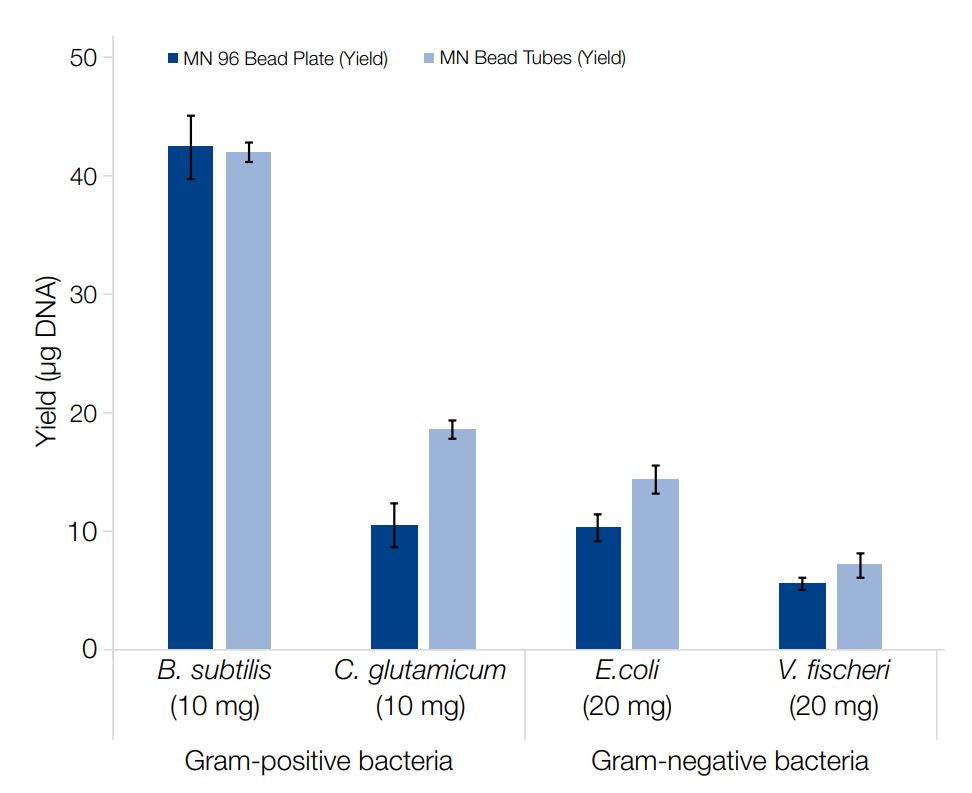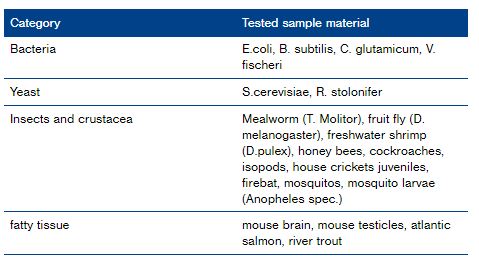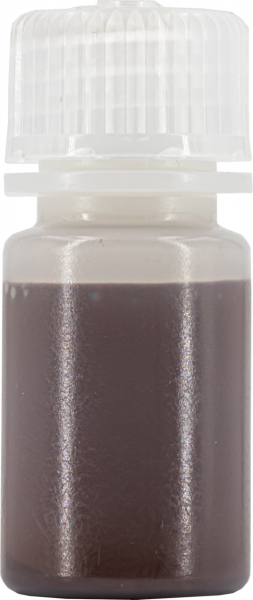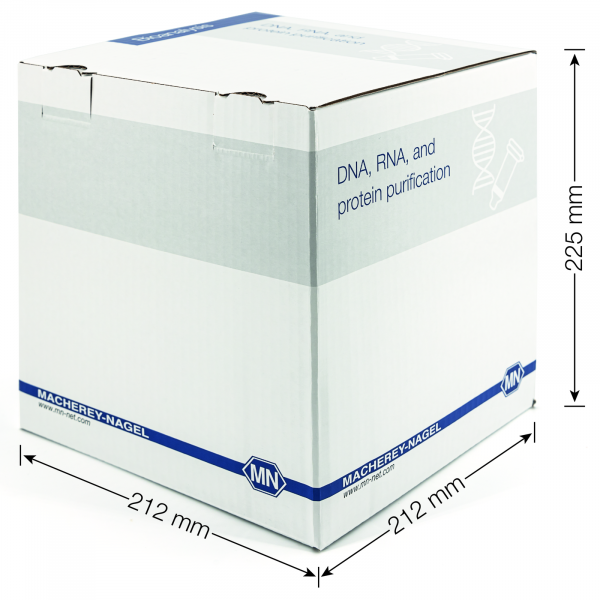NucleoMag DNA Bacteria for DNA purification from bacteria and yeast
*taxes and shipping not included
Magnetic bead based kit for the isolation of genomic DNA from bacteria and yeast
| Application | Isolation of DNA |
| Selling unit | 96 Prep(s), 384 Prep(s) |
| Target | DNA |
| CE certified | No, research use only |
| Technology | Magnetic bead technology |
| Brand | NucleoMag |
| Format | Magnetic beads |
| Handling | Magnetic separation |
| Automated use | Yes |
| Automation support | Compatible with most open robotic platforms. Please visit www.mn-net.com/automation or consult our technical support for further information. |
| Sample material | Animal tissue, Bacteria, Fungi, Human tissue, Insects |
| Sample amount | < 40 mg insects, < 40 mg (10⁸–10⁹) bacteria, < 30 mg fungi, < 30 mg lipid rich tissue, < 40 mg other tissues |
| Theoretical binding capacity | 0.4 µg/µL beads |
| Elution volume | 50–100 µL |
| Preparation time | 40–120 min/96 preps (excl. lysis) |
| Typical downstream application | enzymatic reactions, Next Generation Sequencing, PCR, Real-time PCR, Southern blotting |
| Storage temperature | 15–25 °C / 59–77 °F |
| Shelf life (from production) | 24 Month(s) |
| Hazardous material | Yes |
NucleoMag DNA Bacteria
- Environmentally sustainable buffer chemistry – no chaotropic salts
- Combine with MN Bead Tubes for single sample processing or MN 96 Bead Plates for high throughput sample disruption
- Liquid Proteinase K and Liquid RNase A for easy handling
NucleoMag DNA Bacteria
The NucleoMag DNA Bacteria kit enables high throughput, automation friendly isolation of DNA from diverse microbial samples. The kit is optimal for cultured Gram-positive and Gram-negative bacteria, yeast, and spores. NucleoMag DNA Bacteria utilizes a powerful yet environmentally friendly buffer chemistry, free of chaotropic salts as well as any dangerous goods (patent pending). The kit can be combined with MN Bead Tubes or MN 96 Bead Plates for mechanical disruption.

Efficient DNA extraction with both bead plate and single tube homogenization

Overview of successfully tested sample materials
The NucleoMag DNA Bacteria kit has been evaluated with several different sample types and species. Successful DNA isolation was verified via agarose gel electrophoresis or qPCR.
| Category | Tested sample material |
|---|---|
| Bacteria | E.coli, B. subtilis, C. glutamicum, V. fischeri |
| Yeast | S.cerevisiae, R. stolonifer |
| Insects and crustacea | Mealworm (T. Molitor), fruit fly (D. melanogaster), freshwater shrimp (D.pulex), honey bees, cockroaches, isopods, house crickets juveniles, firebat, mosquitos, mosquito larvae (Anopheles spec.) |
| fatty tissue | mouse brain, mouse testicles, atlantic salmon, river trout |
Competitive detection of microbial DNA

DNA was isolated from Gram-positive and Gram-negative bacteria as well as yeast using the NucleoMag DNA Bacteria kit (MN, blue bars) in comparison to competitor kits Q and T (grey bars). All procedures were performed according to manufacturer‘s recommendations. In comparison to competitors Q (figure A) and T (figure B) the PCR results show significantly earlier amplification (lower CT values), demonstrating superior extraction of microbial DNA. The qPCR was performed for 16s rRNA and 18s rRNA for bacteria and yeast, respectively, using the Maxima SYBR Green kit from Thermo Scientific on Applied Biosystems 7500 Real-Time PCR System.

DNA was isolated from Gram-positive and Gram-negative bacteria using the NucleoMag DNA Bacteria kit. The samples were simultaneously homogenized by using either a rack of prefilled tube strips (BP = MN 96 Bead Plate) or single bead tubes (BT = MN Bead Tubes). Both homogenization systems enable a reliable DNA extraction in combination with the NucleoMag DNA Bacteria kit.
DNA was isolated from various Gram-positive and Gram-negative bacteria using the NucleoMag DNA Bacteria kit in combination with different solutions for sample homogenization and DNA yields were determined by UV spectrometry. The samples were homogenized by using either racks of prefilled tube strips (MN 96 Bead Plates) or single bead tubes (MN Bead Tubes). The results for samples homogenized with MN 96 Bead Plates (dark blue bars) were comparable to the results obtained with homogenization in the MN Bead Tubes (light blue bars).
Reliable DNA integrity with bead plate or single bead tube homogenization



















